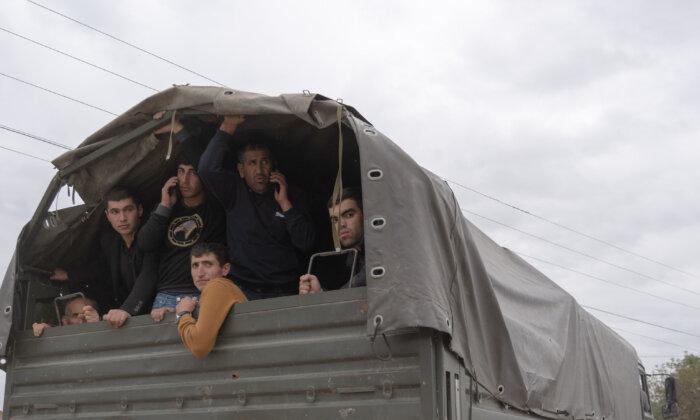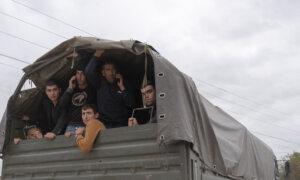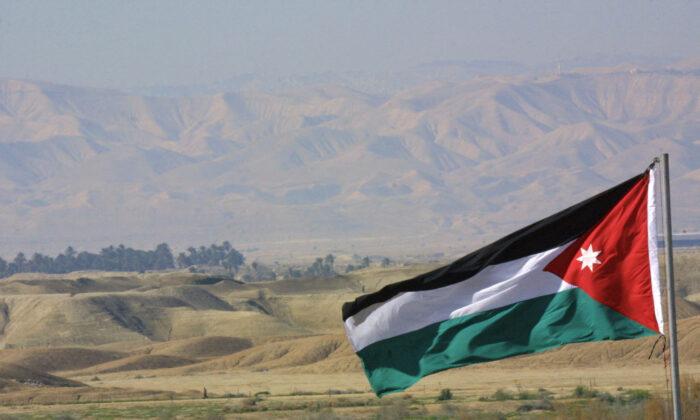Azerbaijan has disputed claims that its forces are “ethnically cleansing” the Nagorno-Karabakh region amid an ongoing exodus by ethnic Armenians to neighboring Armenia.
“Azerbaijan has nothing to do with the decision by local Armenians ... to depart for Armenia or any other country,” the foreign ministry in Baku stated on Sept. 28.
Azerbaijan is “determined to reintegrate [ethnic] Armenian residents as equal citizens based on the national constitution, Azerbaijani law, and its international obligations,” according to the ministry.
About 65,000 refugees—more than half of Nagorno-Karabakh’s total population—have entered Armenia since Azerbaijan began a 24-hour offensive to disarm separatist groups in the region, according to officials in the Armenian capital of Yerevan.
The Epoch Times couldn’t independently verify the figure.
Nikol Pashinyan, Armenia’s prime minister, has asserted that Nagorno-Karabakh’s entire ethnic Armenian population—previously estimated at some 120,000—would likely be gone within “coming days.”
Most, if not all, departing ethnic Armenians appear to be doing so voluntarily.
Nevertheless, Mr. Pashinyan claimed on Sept. 28 that the mass exodus constitutes an “act of ethnic cleansing and deportation” by Azerbaijan.

Armenian police officers stand guard during an anti-government rally in downtown Yerevan on Sept. 25, 2023, following Azerbaijani military operations against Armenian separatist forces in Nagorno-Karabakh. Karen Minasyan/AFP via Getty Images
Baku swiftly condemned Mr. Pashinyan’s assertion, accusing him of attempting to undermine the “prospects for peace between Azerbaijan and Armenia.”
On Sept. 19, Azerbaijan launched a lightning offensive to disarm ethnic Armenian separatists in Nagorno-Karabakh and exert full control over the region.
The operation ended within 24 hours after separatist leaders agreed to lay down their arms in line with a ceasefire agreement brokered by Moscow.
According to Armenian sources, at least 200 ethnic Armenians were killed during the offensive. Baku says 192 Azerbaijani soldiers were killed.
Azerbaijani officials also claim that only “armed formations and military facilities”—not civilians—were targeted during the offensive.
While the vast majority of Nagorno-Karabakh’s inhabitants are ethnic Armenians, the region is internationally recognized as part of Azerbaijan.
PM Blames Russia
Mr. Pashinyan has come under fire from domestic critics for not sending Armenian troops into Nagorno-Karabakh or otherwise trying to stave off Azerbaijan’s offensive. For the past several days, angry protesters have converged on Yerevan’s Republic Square to demand the prime minister’s resignation.Hundreds of Armenian demonstrators have reportedly been detained by police.
However, Mr. Pashinyan blames Moscow for the debacle, saying Russian troops deployed in the region failed to carry out their peacekeeping mandate.
In 2020, Azerbaijan and Armenia fought a six-week war over Nagorno-Karabakh. That conflict, too, ended with a Moscow-brokered ceasefire agreement that left Azerbaijan in control of the region.

Ethnic Armenians from Nagorno-Karabakh gather as they wait to receive humanitarian aid at a temporary camp in Goris, Syunik, Armenia, on Sept. 26, 2023. Vasily Krestyaninov/AP Photo
Since then, Russian peacekeepers have remained deployed along the Armenian-Azerbaijani border, where violence has continued to erupt intermittently.
Armenia is a longstanding member of the Collective Security Treaty Organization (CSTO), a six-nation military alliance led by Moscow.
Although Azerbaijan enjoys close relations with Russia, it isn’t a CSTO member.
In a Sept. 24 address, Mr. Pashinyan enraged Moscow by saying Armenia’s “strategic partnership” with Russia wasn’t enough to ensure its security. Russia’s Foreign Ministry later described his remarks as “unacceptable.”
“They are a clear attempt to shift responsibility for [Yerevan’s] domestic and foreign policy failures by putting the blame on Moscow,” it said in a statement.
US Officials in Region
However, Washington appears to agree with Mr. Pashinyan’s assessment.“I certainly do not think Russia has played a productive role here [in the region] in the past week,” State Department spokesman Matthew Miller said on Sept. 27.
“There have been times where they facilitated [Armenian–Azerbaijani] negotiations, and that was something we welcomed,” he told reporters.
“But certainly, in the last week, their role has not been productive in this situation.”
Earlier this week, Samantha Power, head of the U.S. Agency for International Development, visited Yerevan for talks with Armenian officials.
From there, she flew to Baku, where she met with Azerbaijani President Ilham Aliyev on Sept. 27.
During the meeting, Ms. Power “stressed the urgency of allowing unhindered humanitarian access to Nagorno-Karabakh ... and the urgent need for expanded access [to the region] for humanitarian groups,” according to a spokesperson.
Mr. Aliyev, for his part, assured Ms. Power that the rights of ethnic Armenians—and those of other minorities—weren’t being infringed, Baku said in a statement.

Armenian Prime Minister Nikol Pashinyan addresses parliament following an escalation in hostilities over the Nagorno-Karabakh region along the border of Armenia with Azerbaijan, in Yerevan, Armenia, on Sept. 13, 2022. Tigran Mehrabyan/PAN Photo via Reuters
Ms. Power was accompanied on her trip to the region by Yuri Kim, acting U.S. assistant secretary of state for European and Eurasian affairs.
Earlier this month, Ms. Kim, speaking before the Senate Foreign Relations Committee, urged Washington to step up its efforts to “persuade” Yerevan to shift its allegiance from Moscow to Washington.
Soon afterward, a prominent Russian lawmaker accused the United States of seeking to exploit the Armenian–Azerbaijani dispute to establish an “anti-Russia foothold” in the South Caucasus region.
Shifting Allegiance
In a Sept. 27 interview with the TASS news agency, Russian Foreign Minister Sergey Lavrov claimed that “certain officials” in Yerevan were actively seeking to put Armenia on a pro-Western course.“There are many of those [in the Armenian government] who wish to lose Russia and make new friends,” Mr. Lavrov said.
He also stressed the importance to Russia of the South Caucasus region, which Moscow has historically viewed as its backyard.
“Historically, geographically, and geopolitically, it is impossible to ‘lose’ Russia in the sense of ignoring its interests in the South Caucasus,” Mr. Lavrov said.
“But certain officials in Yerevan entertain such hopes. And they’re openly saying as much.”
Reuters contributed to this report.







